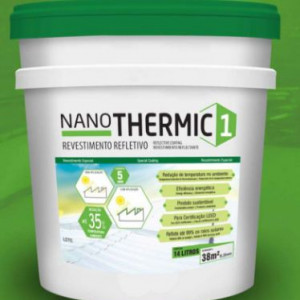| Nanotech Do Brasil |

| Registration Date | 23 Apr 2018 |
| Revision Date | 23 Apr 2018 |
| Share |
Construction Masonry Materials
Thermal Insulation PaintNanothermic1 reflects about 90% of the sun's rays, reducing the surface temperature by up to 50%, being superior to similar products. It has a sri (solar reflection index) of 110.3 being the highest in the national market, attending to several certifications for sustainable constructions. With this high reflectance rate, Nanothermic1 reduces ambient temperature by up to 35%, providing noticeable thermal comfort. With a very simple attitude you can save up to 70% of the electrical energy used for cooling the environment. In addition Nanothermic 1 has low water absorption and reduces rain impact noise with a thickness of only 250 microns by up to 30%. These results will have a significant increase according to the thickness of the applied film. Nanothermic1 provides light weight on the roof, provides durability, weather resistance, solar radiation, aggressive atmosphere and other deteriorating factors providing longevity for its patrimony, which can increase the life of the structure by up to 4 times. The results are visible and immediate, more concentrated employees, better performance and performance, compliance with Regulatory Standards, comfort in the work environment, reduction of labor liabilities, reduction of electricity consumption among other advantages.
Nanothermic1 is a sustainable product that presents the best and most modern thermal insulation system by reflecting solar radiation.
Thermal insulation by reflection is a method adopted to reduce the temperature of environments through the concept of reflection of the solar rays. Unlike conventional thermal insulation methods which consist of creating a barrier (resistance) to hinder heat transfer, reflective thermal insulation reflects the solar rays preventing them from being absorbed by the surface, avoiding their heating and reducing the transfer of thermal load to the surface. environment and thereby lowering the temperature thereof.